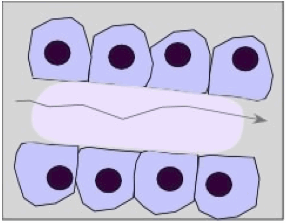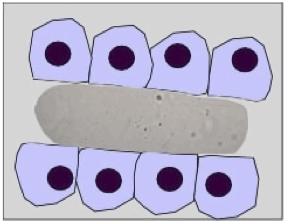Tamm-Horsfall protein
Composition
The Tamm-Horsfall protein, also called uromodulin, is a glycoprotein isolated from normal urine by Tamm and Horsfall in the early fifties. This protein is excreted by the thick ascending branch of the loop of Henle and the first part of the distal tubules. Normal daily excreted quantity ranges from 25 to 50 mg. The protein has a huge molecular weight of around 7 millions Daltons, with 25% to 40% of its weight being carbohydrates. This protein is the major fraction of the uromucoprotein.
Properties
The TH protein has characteristic properties. This protein precipitates as a gel in a 0.58M NaCl solution, and redissolves in deionized water, or in an alkaline buffered solution. If albumine is added to a pure water solution of TH protein, the latter will precipitate and form a gel, taking the shape of the glassware used. Because of this property, casts are believed to dissolve readily in diluted or alkaline urine. Transposing an in-vitro experiment in a real physiological situation is sometimes hasardous. Other factors could stabilize the cast, so that a slight alkalisation (bacterial growth) of the urine does not necessarily mean cast dissolution.
Tamm-Horsfall protein and casts
It as been demonstrated that, hyaline cast, cylindroids, and mucus threads, are all made of Tamm-Horsfall protein fibrils.
Casts are elements of the urinary sediment, formed by the polymerisation of the Tamm-Horsfall fibrils, taking the shape of the site of its formation (casting). Casts are formed, after the loop, in the late section of the distal tubules and the early section of the collecting tubes. The formation site is the nephron's section where the dilution is maximal. As mentioned earlier, fibril's formation is inhibited by a low ionic strenght, and the precipitation is promoted by the addition of albumin. This scheme is quite similar to the environment where casts formation occurs.
The Tamm-Horsfall protein is the cast fundamental substance. It is believed that all the elements needed for cast formation are in place. Some factors (found in abnormal urines) seem to promote casts formation while others (found in normal urines) have an inhibiting effect. Casts are formed when the equilibrium between promoters and inhibitors is broken. Factors known to be promoters of cast formation are:
- Albumin
- Urinary stasis
- Cellular debris
- Low glomerular filtration rate
- Acid pH
- Presence of certain proteins ( Bence-Jones, myoglobin, hemoglobin...)
- Osmolality between 200 and 400 mOsm/Kg
Casts formation
Addis has described many different types of casts, and has established the relation between these casts, and clinical conditions. He has also proposed an evolution scheme for casts. In his proposal, cellular casts degenerate as coarsly granular casts, which degenerate in finely granular casts, and finally become waxy casts.
Haber has demonstrated that the waxy casts were made of an amorphous material, associated with Tamm-Horsfall fibrils. This structure does not support the evolution theory of Addis. On the other hand, Lindner has demonstrated that type II granular casts (finely granular) are related to the granular cytoplasm of degenerated renal tubular cells.
Some relation between the different casts is demonstrated, but the complete evolution theory of Addis was presented as, and remains, a speculation.
Lindner's mechanism of cast formation
The casts matrix is formed of uromucoprotein fibrils and is builded by a mechanism described by Lindner. The mechanism has four steps: initiation, growth, maturation, and evacuation.
Initiation
 The first fibrils are fixed to the distal, or collector
tubular walls, forming a porous sponge like lattice. Since the
initial cast has large pores, urine and small debris pass
through. These initial fibrils are made of Tamm-Horsfall protein.
This stage could correspond to the early hyaline cast described
by Lindner.
The first fibrils are fixed to the distal, or collector
tubular walls, forming a porous sponge like lattice. Since the
initial cast has large pores, urine and small debris pass
through. These initial fibrils are made of Tamm-Horsfall protein.
This stage could correspond to the early hyaline cast described
by Lindner.
Growth
As time goes, more and more elementary fibrils, and maybe other proteins, are added to the initial structure, making the pore smaller. The declining pores size reduces the urine flow through the structure. The flow will eventually stop.
Maturation
 After complete obstruction of urine flow, the cast matrix is
modified by the tubular activity. The maturation period depends
on the nephron activity, especially at the blockade region.
Proteins, probably originating from the surrounding tubular
cells, are added to the structure.
After complete obstruction of urine flow, the cast matrix is
modified by the tubular activity. The maturation period depends
on the nephron activity, especially at the blockade region.
Proteins, probably originating from the surrounding tubular
cells, are added to the structure.
Evacuation
Because of the surrounding cells activity and the hydrostatic pressure, a time comes where the cast loses its adherence to the tubular wall. The casts are then evacuated by the urinary flow.